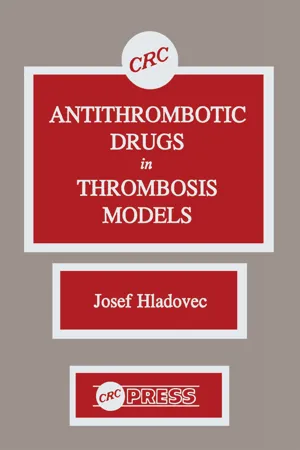
- English
- ePUB (mobile friendly)
- Available on iOS & Android
Antithrombotic Drugs in Thrombosis Models
About This Book
Antithrombotic Drugs in Thrombosis Models presents a critical review of the use of thrombosis models and an original, highly sensitive methodology for testing antithrombotics based on a more adequate understanding of thrombotic processes. The methods form an integrated system stressing particularly the plurifactorial and global character of thrombosis and the key role of a generalized mild endothelial lesion. Packed with illustrations, this book documents the effectiveness of the system through the screening of a series of acknowledged and potential antithrombotics, and includes a unique study of their mutual combinations. Special emphasis is placed on the importance of biomodels for preliminary testing of antithrombotics. This book is particularly useful to researchers in pharmacology and the pharmaceutical industry; however, those interested in drug research and the field of cardiovascular medicine will benefit as well.
Frequently asked questions
Chapter 1
INTRODUCTION
Chapter 2
THE RATIONAL BASIS OF THROMBOSIS MODELS
I. THE THROMBOSIS TRIAD
Thrombosis Triad and its Contemporary Correlates
Originally | Presently |
Humoral factor | Blood clotting |
(“crasis”) | Fibrinolysis |
Platelets | |
Stasis | Hemodynamic factors |
Hemorheologic factors | |
Vascular lesion | Vascular lesion |
II. THROMBOSIS FACTORS
A. Humoral Factors
1. Blood Clotting System
Table of contents
- Cover
- Title Page
- Copyright Page
- Preface
- The Author
- Table of Contents
- Chapter 1 Introduction
- Chapter 2 The Rational Basis of Thrombosis Models
- Chapter 3 Basic Methods
- Chapter 4 Effects of Antithrombotics and Results of Drug Screening
- Chapter 5 Drug Combinations
- Chapter 6 General Conclusions
- Index